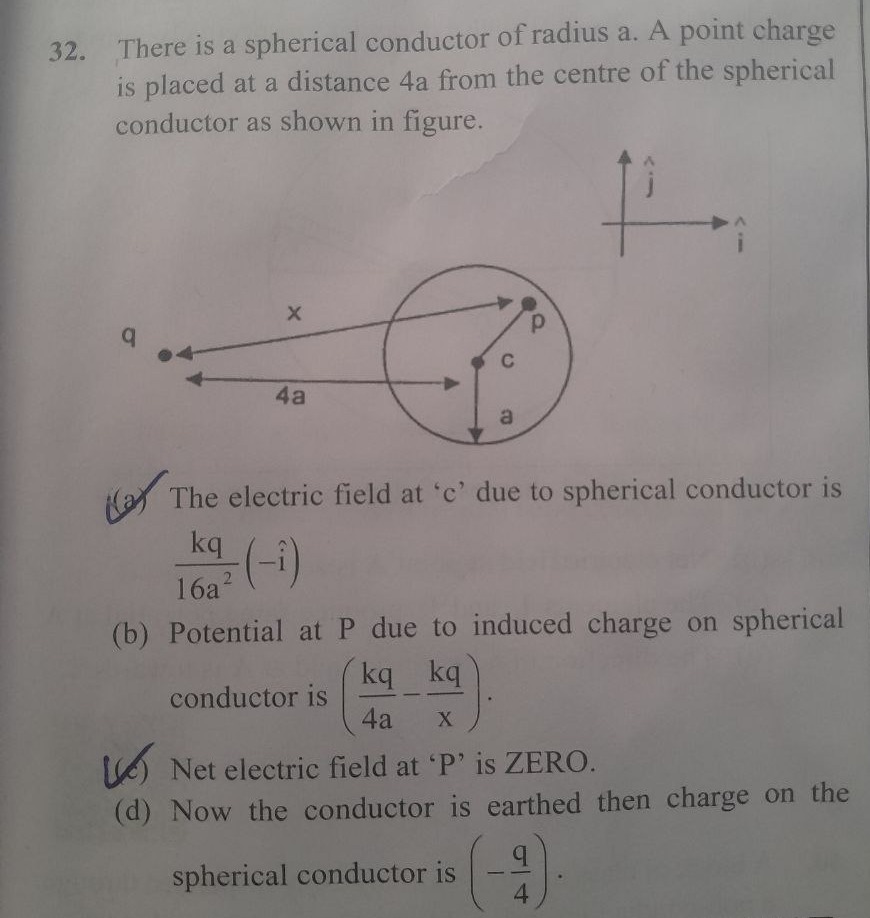Question
Question: There is a spherical conductor of radius a. A point charge is placed at a distance 4a from the centr...
There is a spherical conductor of radius a. A point charge is placed at a distance 4a from the centre of the spherical conductor as shown in figure.

The electric field at 'c' due to spherical conductor is 16a2kq(−i^)
Potential at P due to induced charge on spherical conductor is (4akq−xkq).
Net electric field at 'P' is ZERO.
Now the conductor is earthed then charge on the spherical conductor is (−4q).
(a), (b), and (d) are correct.
Solution
Let's analyze the problem step‐by‐step.
Step 1. Field at the Centre (Statement a)
For an isolated conductor in electrostatic equilibrium the field inside is zero. Thus, at the centre “c” the field due to the induced charges must exactly cancel the field due to the external point charge.
-
Field due to q at the centre:
Eq=(4a)2kq=16a2kq
The point charge q is at a distance 4a from c, soand it points along the +i^ direction (i.e. from c towards q).
-
Thus, the induced charges must produce a field:
Einduced=16a2kq(−i^)which exactly cancels Eq at c.
✓ Statement (a) is correct.
Step 2. Potential at a Point on the Sphere (Statement b)
Let P be any point on the surface of the conductor. Since the conductor is an equipotential, let’s denote the surface potential as V0. Using the uniqueness theorem (or by noting that the external field from q gives a nonuniform contribution on the surface) we have:
-
Potential at the centre (or anywhere on the sphere) due to q:
Vq=4akq
At c the distance from the external charge is 4a, givingHence the whole conductor is raised to this potential.
-
On the surface at P:
Vq(P)=xkq,
The potential due to q iswhere x is the distance from q to P.
To maintain the equipotential value V0=4akq, the induced charges must provide a potential
Vinduced(P)=V0−Vq(P)=4akq−xkq.✓ Statement (b) is correct.
Step 3. Net Electric Field at P (Statement c)
At the surface of a conductor, the electric field is normal to the surface and is given by E=σ/ε0. In an electrostatic scenario, the tangential component is zero but the normal component is not necessarily zero.
✓ Thus, saying the net electric field at P is zero is incorrect.
Statement (c) is false.
Step 4. Charge on a Grounded Conductor (Statement d)
When the conductor is earthed, it is held at zero potential. In the method of images for a grounded sphere of radius a with an external charge q at a distance d from the centre, the image charge is given by:
q′=−qda.Here, d=4a so
q′=−q4aa=−4q.This image charge represents, in effect, the charge induced on the sphere when it is grounded.
✓ Statement (d) is correct.
The correct statements are (a), (b) and (d).
Summary (Minimal Explanation)
- (a): At the centre, the induced charge field cancels the field from q. Since Eq=kq/(16a2) (pointing right), the induced field is kq/(16a2)(−i^).
- (b): The sphere being equipotential (at kq/4a) means that the potential due to induced charges at point P is Vinduced(P)=4akq−xkq.
- (c): While the tangential component of E vanishes, the normal component is non-zero on the surface.
- (d): For a grounded sphere, the induced (image) charge is −q4aa=−4q.
